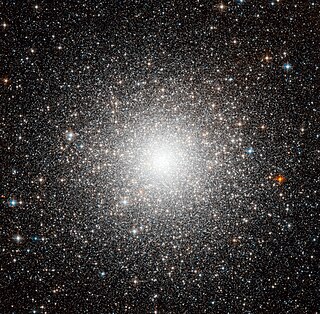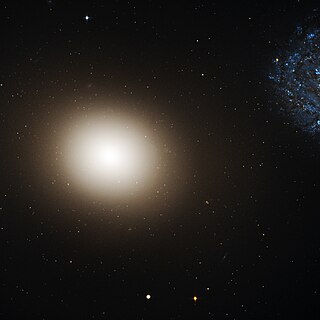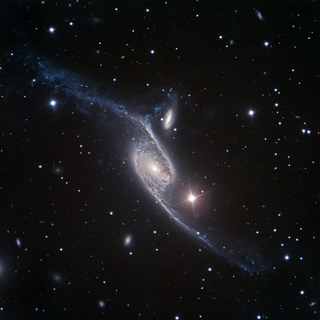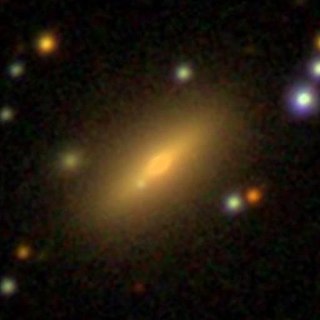
Abell 1835 IR1916 was a candidate for being the most distant galaxy ever observed, although that claim has not been verified by additional observations. It was claimed to lie behind the galaxy cluster Abell 1835, in the Virgo constellation.

Messier 54 is a globular cluster in the constellation Sagittarius. It was discovered by Charles Messier in 1778 and then included in his catalog of comet-like objects.

Messier 59 or M59, also known as NGC 4621, is an elliptical galaxy in the equatorial constellation of Virgo. It is a member of the Virgo Cluster, with the nearest fellow member 8′ away and around 5 magnitudes fainter. The nearest cluster member of comparable brightness is the lenticular galaxy NGC 4638, which is around 17′ away. It and the angularly nearby elliptical galaxy Messier 60 were both discovered by Johann Gottfried Koehler in April 1779 when observing comet seeming close by. Charles Messier listed both in the Messier Catalogue about three days after Koehler's discovery.

Messier 60 or M60, also known as NGC 4649, is an elliptical galaxy approximately 57 million light-years away in the equatorial constellation of Virgo. Together with NGC 4647, it forms a pair known as Arp 116. Messier 60 and nearby elliptical galaxy Messier 59 were discovered by Johann Gottfried Koehler in April 1779, observing a comet in the same part of the sky. Charles Messier added both to his catalogue about three days after this.

A dwarf galaxy is a small galaxy composed of about 1000 up to several billion stars, as compared to the Milky Way's 200–400 billion stars. The Large Magellanic Cloud, which closely orbits the Milky Way and contains over 30 billion stars, is sometimes classified as a dwarf galaxy; others consider it a full-fledged galaxy. Dwarf galaxies' formation and activity are thought to be heavily influenced by interactions with larger galaxies. Astronomers identify numerous types of dwarf galaxies, based on their shape and composition.

Messier 77 (M77), also known as NGC 1068 or the Squid Galaxy, is a barred spiral galaxy in the constellation Cetus. It is about 47 million light-years (14 Mpc) away from Earth. Messier 77 was discovered by Pierre Méchain in 1780, who originally described it as a nebula. Méchain then communicated his discovery to Charles Messier, who subsequently listed the object in his catalog. Both Messier and William Herschel described this galaxy as a star cluster. Today, however, the object is known to be a galaxy.

The Antennae Galaxies are a pair of interacting galaxies in the constellation Corvus. They are currently going through a starburst phase, in which the collision of clouds of gas and dust, with entangled magnetic fields, causes rapid star formation. They were discovered by William Herschel in 1785.

NGC 6872, also known as the Condor Galaxy, is a large barred spiral galaxy of type SB(s)b pec in the constellation Pavo. It is 212 million light-years (65 Mpc) from Earth. NGC 6872 is interacting with the lenticular galaxy IC 4970, which is less than one twelfth as large. The galaxy has two elongated arms with a diameter based on ultraviolet light of over 522,000 light-years (160,000 pc), and a D25.5 isophotal diameter of over 717,000 light-years (220,000 pc), making it the largest known spiral galaxy. It was discovered on 27 June 1835 by English astronomer John Herschel.

The SSA22 Protocluster, also known as EQ J221734.0+001701, is a galaxy protocluster located at z=3.1 in the SSA 22 region. It is located at 22h 17m 34.0s +00° 17′ 01″ and was originally discovered in 1998.

M60-UCD1 is an ultracompact dwarf galaxy. It is 49 million light years from Earth, close to Messier 60 in the Virgo Cluster. Half of its stellar mass is in the central sphere 160 light years in diameter.

Cosmos Redshift 7 is a high-redshift Lyman-alpha emitter galaxy. At a redshift z = 6.6, the galaxy is observed as it was about 800 million years after the Big Bang, during the epoch of reionisation. With a light travel time of 12.9 billion years, it is one of the oldest, most distant galaxies known.

M59-UCD3 is an ultra-compact dwarf galaxy located near the Messier 59 galaxy. As of 2015, it is the second-densest galaxy currently observed, second to M85-HCC1.
MACHO 176.18833.411 is an RR Lyrae variable star located in the galactic bulge of our Milky Way Galaxy. However, it is not a galactic bulge star, it is a galactic halo star, which is on the part of its elliptical orbit that brings it within the bulge before returning to the outer parts of the galaxy, the halo. The star is currently located about 850 pc (2,800 ly) from the Galactic Center. As of 2015, this star has the highest velocity of any known RR Lyrae variable located in the bulge, moving at 482 km/s (1,080,000 mph), only slightly below galactic escape velocity, and 5x the average velocity of bulge stars. Its nature was discovered as part of the BRAVA-RR survey.
PSR J0540−6919 is a pulsar in the Tarantula Nebula of the Large Magellanic Cloud. It is the first extragalactic gamma-ray pulsar discovered.
Red nuggets is the nickname given to rare, unusually small galaxies packed with large amounts of red stars that were originally observed by Hubble Space Telescope in 2005 in the young universe. They are ancient remnants of the first massive galaxies. The environments of red nuggets are usually consistent with the general elliptical galaxy population. Most red nuggets have merged with other galaxies, but some managed to stay unscathed.

NGC 1271 is a compact elliptical or lenticular galaxy located about 250 million light-years away in the constellation Perseus. The galaxy was discovered by astronomer Guillaume Bigourdan on November 14, 1884. NGC 1271 is a member of the Perseus Cluster and has a nuclear dust disk in its center. It also has an edge-on, intermediate-scale disk and has a central bulge. Like NGC 1277, NGC 1271 is a candidate "relic galaxy".

NGC 1281 is a compact elliptical galaxy located about 200 million light-years away in the constellation Perseus. NGC 1281 was discovered by astronomer John Dreyer on December 12, 1876. It is a member of the Perseus Cluster.
PKS1353-341, also known as LEDA 88936 is a quasar located in the southern constellation Centaurus. It has an apparent magnitude of 18.5, making it only visible in powerful telescopes. Based on the object's luminosity, it is estimated to be 3.7 billion light years distant from the Solar System. It is receding from the Milky Way with a heliocentric radial velocity of 59,531 km/s














